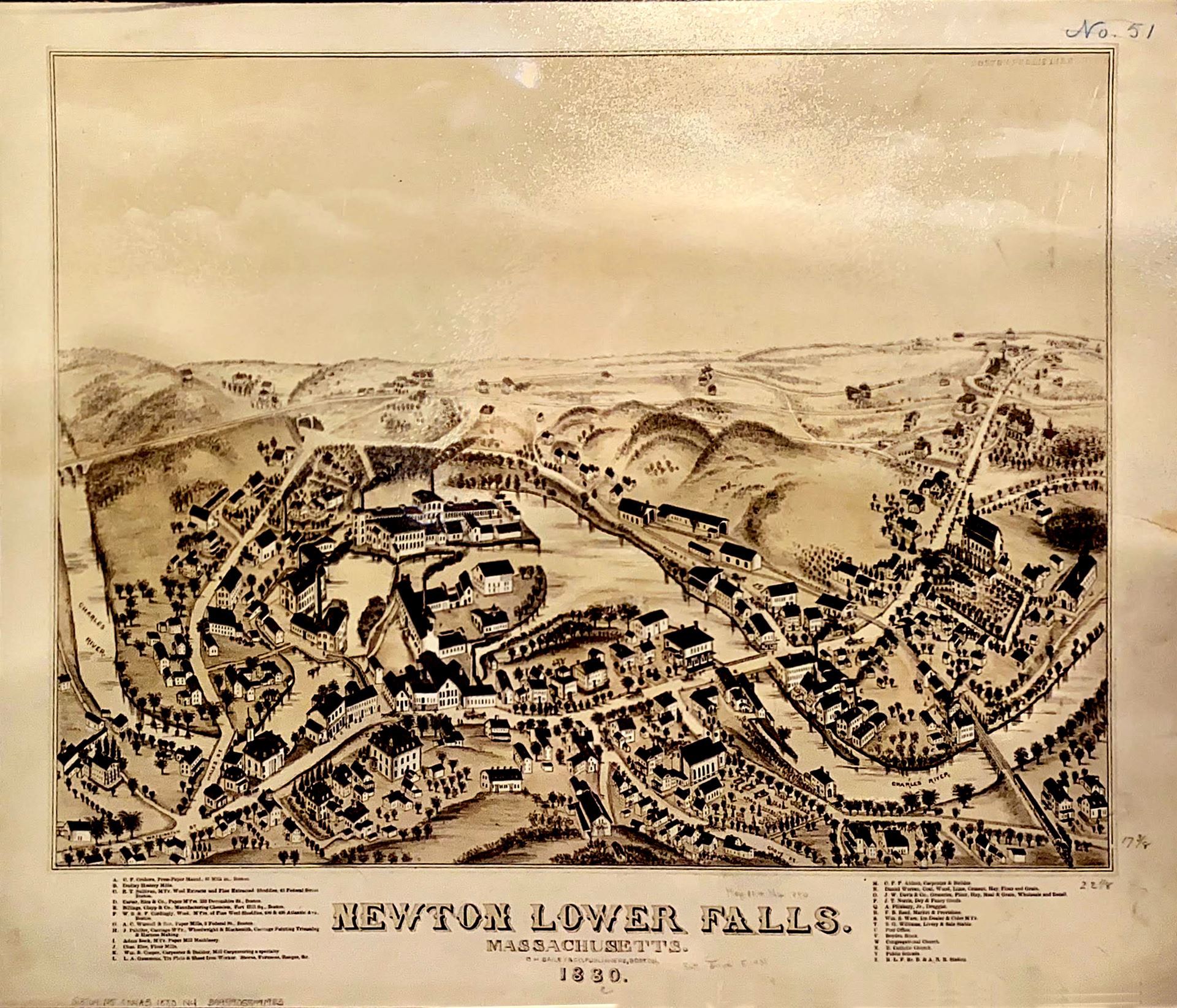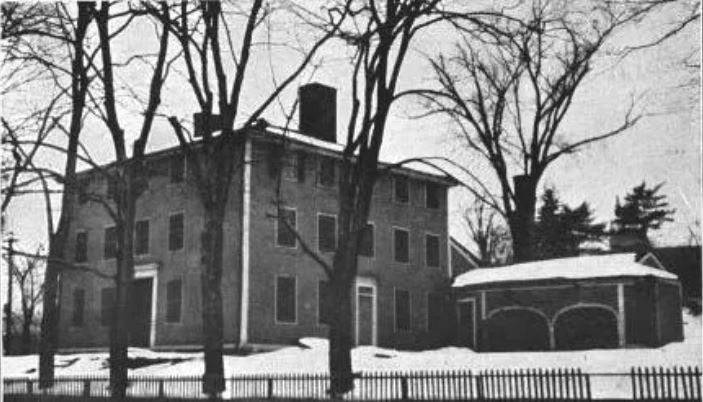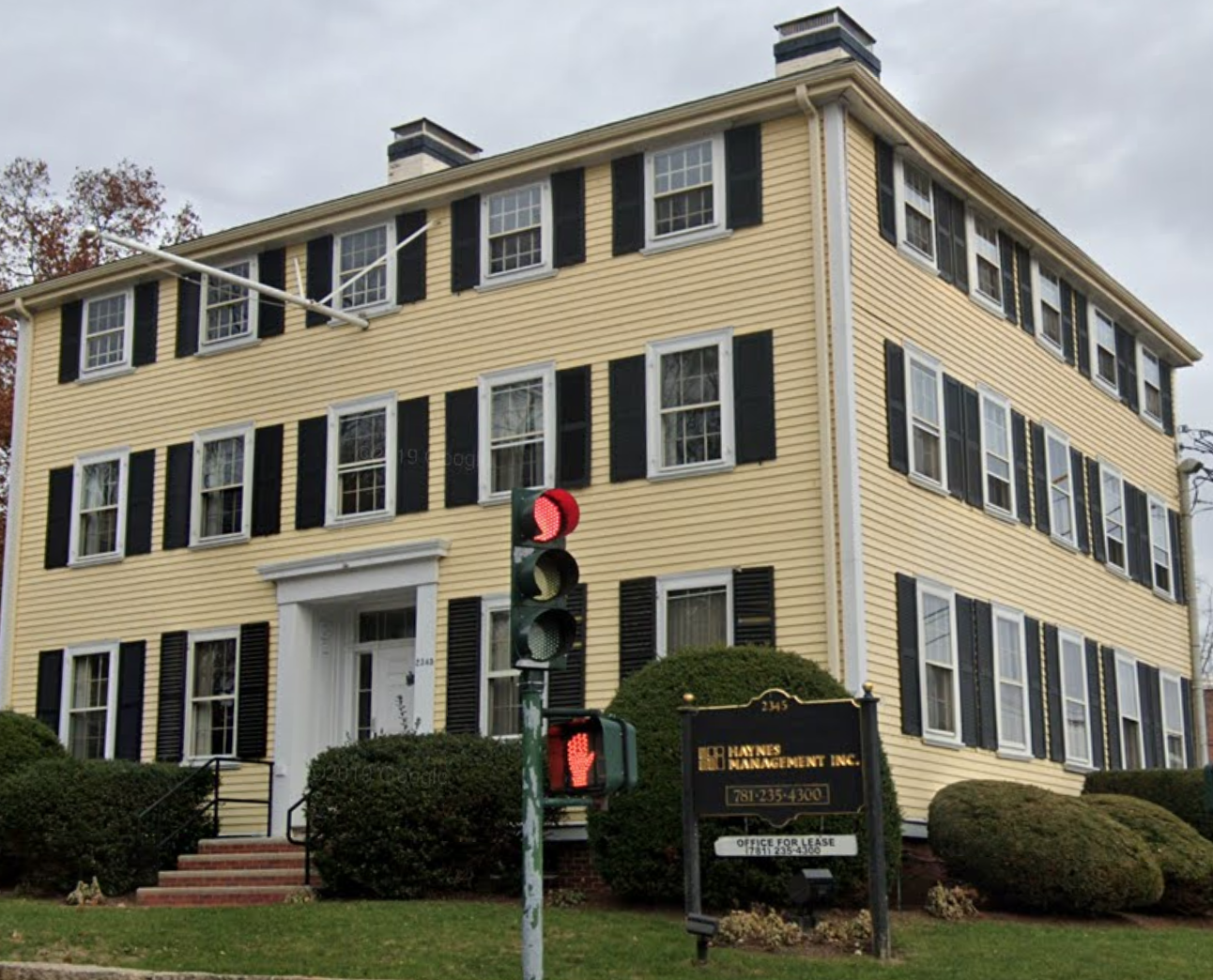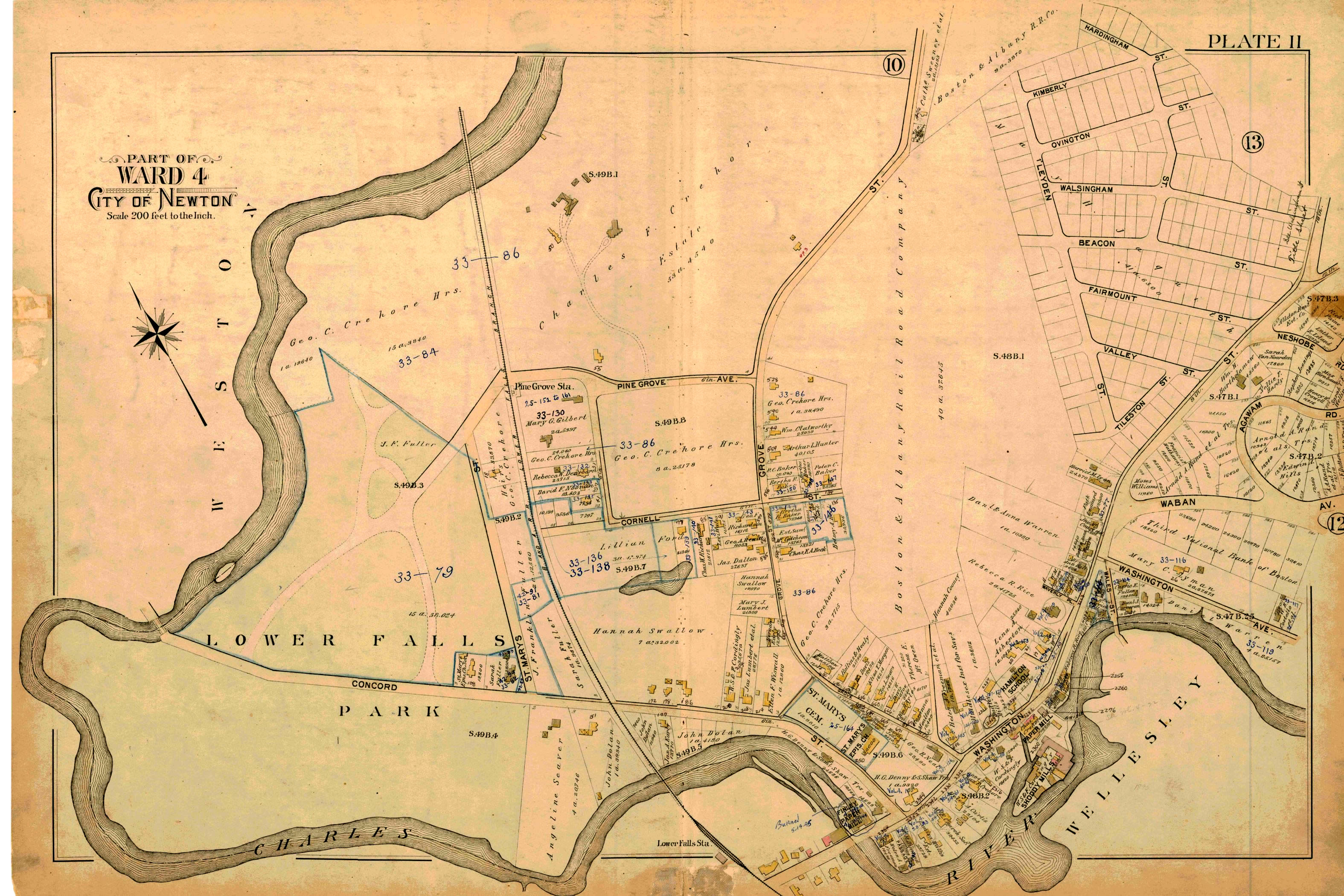|
The History of Lower Falls
Newton Lower Falls has a rich history. A brief summary follows, based on the detailed slide shows created by neighbor and local historian Tori Zissman.
You can visit Tori's slideshows here: Newton Lower Falls: A History Exploration slide show and Special Riverside Edition.
Before the arrival of English colonists, the area around Newton Lower Falls was likely inhabited by the Massachusett tribe, living in a large village called Coowate. The river, waterfalls, and bluffs were ideal for fishing and hunting.
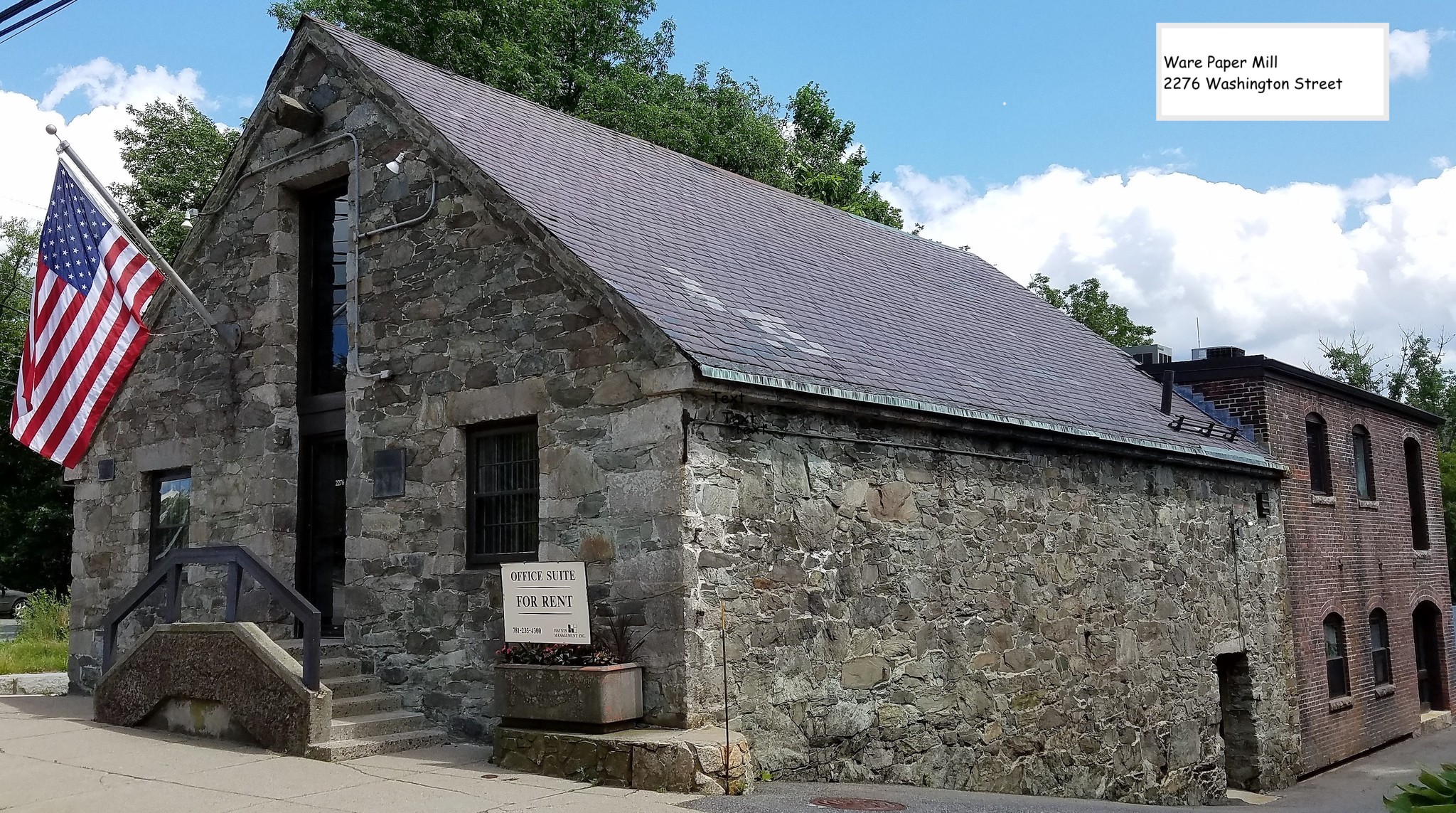 Newton, once part of Cambridge, had been established as a separate town in 1688. In 1704, John Hubbard acquired land in what would become Newton Lower Falls. Hubbard and Caleb Church built a dam to generate power for an ironworks. Other industries, including a gristmill and a sawmill followed. When John Ware introduced papermaking in 1790, it became the village’s primary industry. (Ware’s stone mill is still standing at 2276 Washington Street.) By 1816, there were six paper mills in Lower Falls.
Newton, once part of Cambridge, had been established as a separate town in 1688. In 1704, John Hubbard acquired land in what would become Newton Lower Falls. Hubbard and Caleb Church built a dam to generate power for an ironworks. Other industries, including a gristmill and a sawmill followed. When John Ware introduced papermaking in 1790, it became the village’s primary industry. (Ware’s stone mill is still standing at 2276 Washington Street.) By 1816, there were six paper mills in Lower Falls.
Throughout the 19th century, Newton Lower Falls developed into a thriving industrial center, with houses, taverns, and shops. St. Mary’s Church, the oldest church still standing in Newton, was built in 1813. (Several Revolutionary War veterans are buried in the graveyard.)
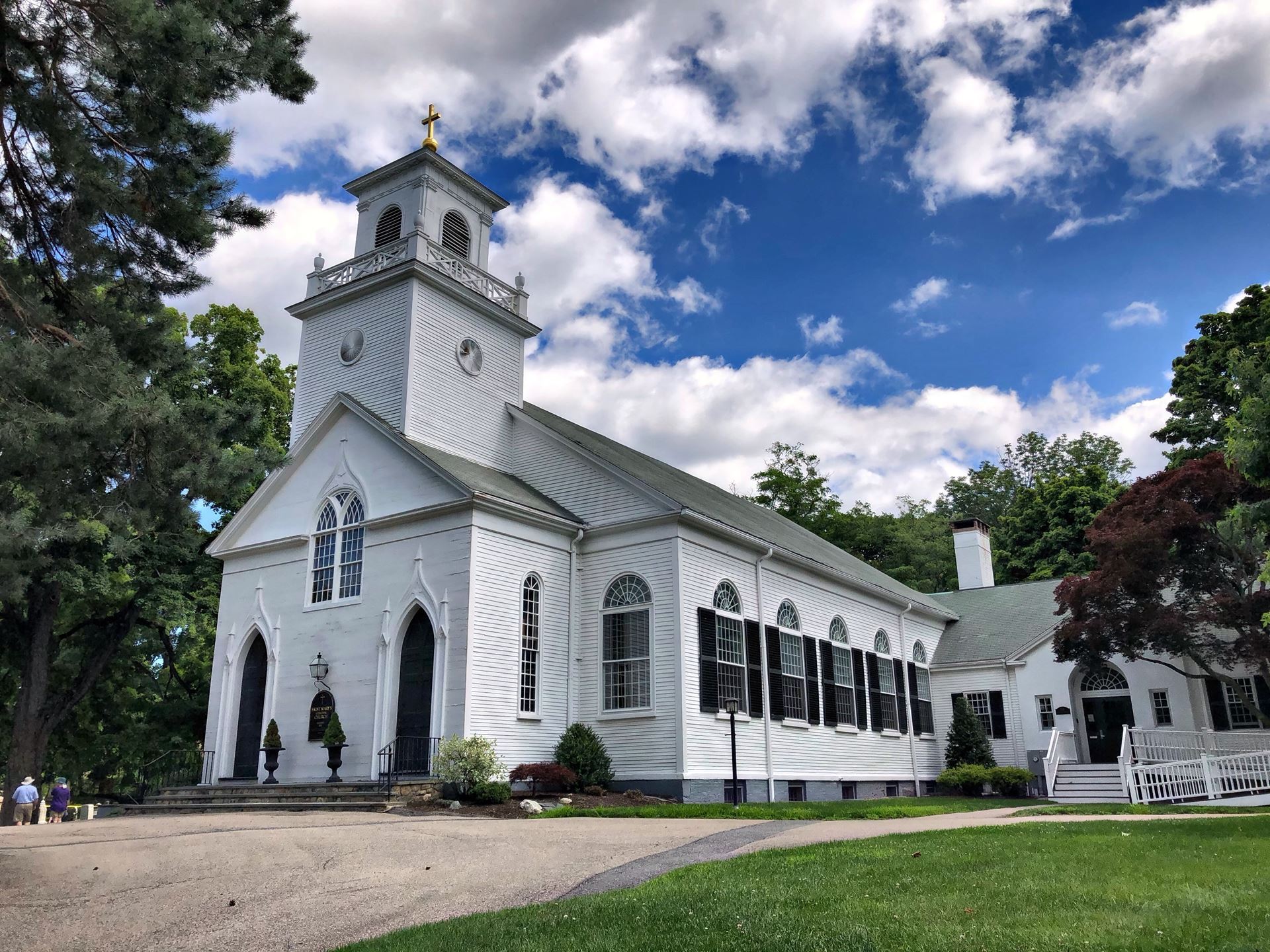
St. Mary’s Church
A proposed railroad was rejected in 1830, but 10 years later, a spur to the main line, known as a “ping pong” line, was built. Newton’s first fire station was organized in Lower Falls in 1813, eventually moving to 677 Grove Street in 1900.
Prominent papermakers included Solomon Curtis (and later his sons Allen and William), Lemuel Crehore, and Benjamin Neal. Zenas Crane, Henry Wiswall, and John Willard began their careers in Lower Falls. In 1801, they founded a paper mill in Dalton, MA, which has made banknote paper for all U.S. currency since 1879.
The Baury House at 2354 Washington Street is probably the oldest surviving house in Newton Lower Falls. Built in 1755 as a wedding present for Ezra and Sarah Parker, it has changed over time. (It was even rotated 90 degrees during urban redevelopment in the 1960s.)
Members of the Crane family lived at 204-206 Concord Street. Allen Curtis owned the impressive house on Quinobequin Road that would later become the Pillar House Restaurant (now relocated to Lincoln, MA), and William Curtis lived at 2330 Washington Street.
Many of the houses along Grove Street were built in the 1800s for mill owners and workers, including: #584, #585, #640 #646, #650, #656. Also built during that time were the homes at #660, #665, and #671 Grove Street, attributed to local carpenter-builder Vaughn Jones, and #666 and #676 Grove Street, built by local housewright William Lyon. (The Hagar family lived at 640 Grove Street and the Moulton family lived at 676 Grove Street.)
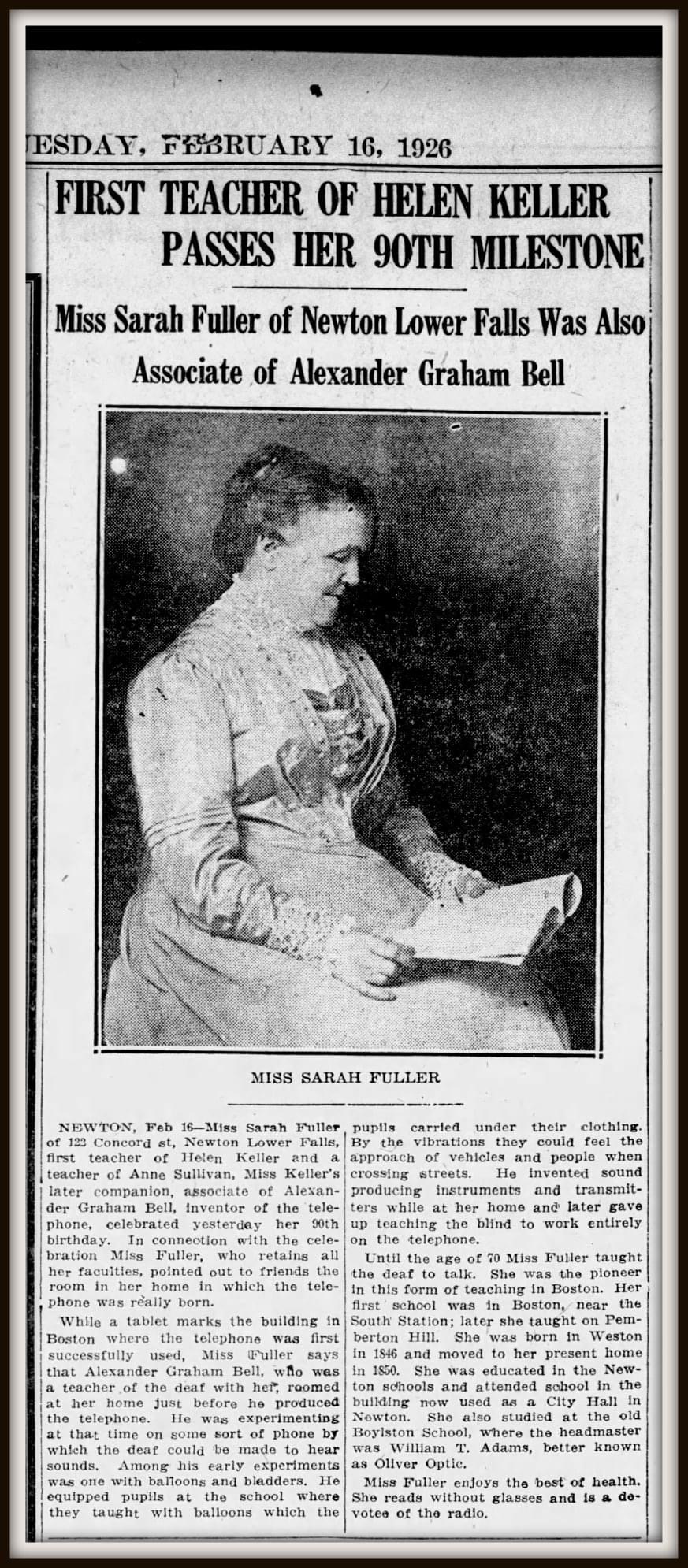 One of the innovations associated with Newton Lower Falls is the telephone. In the 1870s, Alexander Graham Bell came to Boston to work at the Horace Mann School for the Deaf, founded by educational pioneer Sarah Fuller. He was an occasional visitor to 122 Concord Street where Fuller lived, in a house built by William Jordan and her brother-in-law, Allen Jordan. During her long career, Fuller worked with both Helen Keller and Helen’s teacher, Anne Sullivan.
One of the innovations associated with Newton Lower Falls is the telephone. In the 1870s, Alexander Graham Bell came to Boston to work at the Horace Mann School for the Deaf, founded by educational pioneer Sarah Fuller. He was an occasional visitor to 122 Concord Street where Fuller lived, in a house built by William Jordan and her brother-in-law, Allen Jordan. During her long career, Fuller worked with both Helen Keller and Helen’s teacher, Anne Sullivan.
Local inventor and scientist Francis Blake worked for Alexander Graham Bell. His invention of the “Blake transmitter” was essential to the success of Bell Telephone. After marrying Elizabeth Hubbard, the couple built a legendary estate known as “Keewaydin,” by the Lower Falls/Weston line. Along with his brother-in-law Charles Hubbard, Blake donated land that is now part of the Leo J. Martin Golf Course. The estate, with its formal gardens, terraces, and cottages, was torn down and subdivided in the 1960s.
Newton Lower Falls has been home to other notable people, including Pulitzer Prize-winning poet Anne Sexton (40 Clearwater Road), Nobel Prize winner Michael Rosbash, and State Representative Kay Khan.
In 1924, the city purchased Hamilton Field, once part of the substantial 19th century Crehore estate, with funds partially donated by local residents. The Hamilton School was built about 5 years later, replacing earlier school locations. (The first school in Lower Falls was built in 1785.) In 1923, the Newton Free Library’s first branch library opened in Lower Falls in the former fire station at 677 Grove Street.
In 1925, the Crehore estate was subdivided into the following roads: Clearwater, Deforest, Crehore, Pierrepoint, Sherrin, Hallron, and Goff. Although a development called “Barbara Park” was not completed as planned, many houses in this area were built from the 1930s through the 1950s.
Development increased rapidly in the post-World War II years. The MTA opened the Riverside station in 1959. Construction of Route 128 began in 1952, changing the landscape of the neighborhood, as did urban renewal in the 1960s and 1970s. Several houses along Grove Street were removed; some were relocated while other historic buildings along Washington Street were demolished.
Community spirit has long characterized the neighborhood. The nonprofit Lower Falls Improvement Association (LFIA) began in 1939 to represent and advocate for the community. The fight against the closure of the Hamilton School led to an annual neighborhood party known as the Falls Ball, started by then-Alderman John Stewart in June 1975. Although the school eventually closed in 1978, the tradition continued uninterrupted for over 40 years.
Other events sponsored by the LFIA or organized by neighbors include the Halloween Party, Progressive Dinner, Valentine’s Day Dance, and movie nights at Hamilton Field. The Lower Falls Lowdown, a neighborhood newsletter and an active listserv help neighbors stay in touch. In 2013, and again in 2019, the neighborhood rallied to object to the size and scope of the planned mixed-use development at Riverside. (For a historical perspective on Riverside, see Tori Zissman’s Special Riverside Edition slide show.)
Notes
See “Discover Newton Lower Falls,” a walking tour developed by the Newton Planning and Development Department in conjunction with the Newton Historical Commission, 2002.
Buildings of New England contains photographs of homes along Grove Street built for mill workers.
For more about Sarah Fuller, visit: https://www.boston.gov/news/sarah-fuller-early-deaf-education-advocate
For more about Keewaydin, visit: https://wellesleywestonmagazine.com/past-issues/summer-2010-table-contents/francis-blake-and-charles-wells-hubbard/

